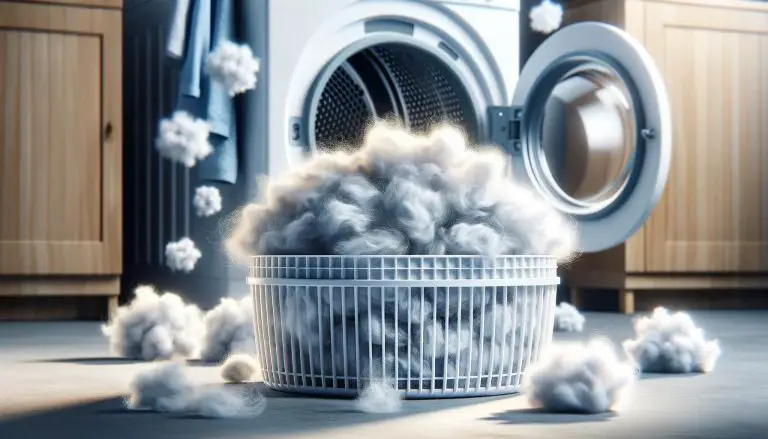Are you cleaning out your dryer’s lint trap and wondering, “Where does all this lint come from?”
Cleaning out the lint from your dryer is not so much fun and knowing where it comes from can help you better understand and manage your laundry process.
Dryer lint comes from the fibers shed from our clothes during the drying process, combined with dust and other particles, accumulating in the lint trap. The amount and type of lint produced vary based on the nature of the fabrics being dried, the age and condition of the clothes, and the specific settings and usage of the dryer.
In this article, we’ll explain where dryer lint comes from, shed light on its composition, and formation, and the critical reasons why it demands our attention.
Table of Contents

Understanding Dryer Lint
Most people think Dryer lint is a mere byproduct of laundry, and nothing more.
It’s essential to understand what constitutes dryer lint and the common misconceptions surrounding it.
Composition of Dryer Lint
Dryer lint is not just a random accumulation of fluff; it’s a composite material with a specific makeup.
Here are the main constituents of dryer lint:
- Fabric Fibers: The majority of lint is composed of fibers from various fabrics. These include natural fibers like cotton and wool, as well as synthetic fibers from garments.
- Dust and Pet Hair: Alongside fabric fibers, lint can also contain dust, pet hair, and other microscopic particles that adhere to clothing during regular wear and washing.
- Foreign particles
Common Misconceptions about Dryer Lint
There are several myths and misunderstandings about dryer lint that need to be addressed:
- Lint is Only Fabric: While fabric fibers are a significant component, lint also includes other elements like dust, foreign particles, and hair.
- All Dryers Produce the Same Amount of Lint: The amount of lint produced can vary greatly depending on the type and condition of the clothes and the dryer’s model and settings.
- Lint is Harmless: Contrary to this belief, lint can pose fire hazards and affect the efficiency of your dryer.
How is dryer lint created?
The process of dryer lint formation is a combination of mechanical action, heat, and airflow within the dryer.
As clothes tumble in the dryer, they rub against each other. This friction causes tiny fibers from the fabrics to break loose.
The heat of the dryer accelerates the shedding of fibers, while the airflow carries these loose fibers to the lint trap, where they accumulate as lint.
Different fabrics shed differently. For instance, towels and fleece tend to produce more lint than synthetic fabrics. Also, aggressive washing cycles or high-heat drying can increase the amount of lint produced.
Why does dryer lint matter?
The significance of dryer lint extends beyond a mere laundry byproduct.
Dryer lint plays a crucial role in both home safety and the efficiency of your laundry appliances.
Safety Concerns: Fire Hazards Associated with Lint
Lint accumulation, particularly in the dryer vent, poses a significant fire hazard. The flammable nature of lint, combined with restricted airflow and high heat, can create dangerous conditions.
According to the U.S. Fire Administration, thousands of home fires each year are attributed to clothes dryers, with the leading cause being lint buildup.
Efficiency and Appliance Longevity
Beyond safety, managing dryer lint is vital for maintaining the efficiency and longevity of your dryer.
A clogged lint trap or vent can severely hamper the airflow, leading to longer drying times and increased wear on the dryer.
Regular lint removal can help maintain the dryer’s energy efficiency, reducing both energy consumption and costs.
How to manage dryer lint effectively
Effective management of dryer lint is not just about cleaning the lint trap. It involves a series of practices that ensure the safety and efficiency of your dryer.
- Clean After Every Use: Remove lint from the trap after every dryer cycle. This simple habit can significantly reduce the risk of lint-related hazards.
- Deep Cleaning: Occasionally, use a vacuum or a special brush to remove lint that has bypassed the trap and accumulated deeper within the dryer.
- Sort Laundry by Fabric Type: Washing and drying similar fabrics together can reduce overall lint production.
- Use Lower Heat Settings: High heat can exacerbate fiber shedding. Opt for lower heat settings when possible.
- Schedule Regular Inspections: Have a professional inspect and clean your dryer vent annually. This is especially important for vents that are long or have several turns.
- Signs You Need Professional Cleaning: If your dryer takes longer than usual to dry clothes or the outer surface gets very hot, it might be time for a professional cleaning.
Conclusion
Knowing how dryer lint comes about and how to deal with it is equally as important as drying your clothes.
Key Takeaways:
- Dryer Lint’s Composition: Comprises mostly of fabric fibers, along with dust and pet hair.
- Formation and Factors: The mechanical action and heat in dryers contribute to lint formation, with factors like fabric type and laundry methods playing significant roles.
- Safety and Efficiency: The importance of managing dryer lint extends beyond cleanliness, impacting both the safety of our homes and the efficiency of our appliances.
- Effective Management: Regular cleaning of lint traps, mindful laundry practices, and professional vent cleaning are essential steps in effective lint management.
- Technological Innovations: Advancements in dryer technology and additional tools are making lint management more efficient and user-friendly.
Related articles:

